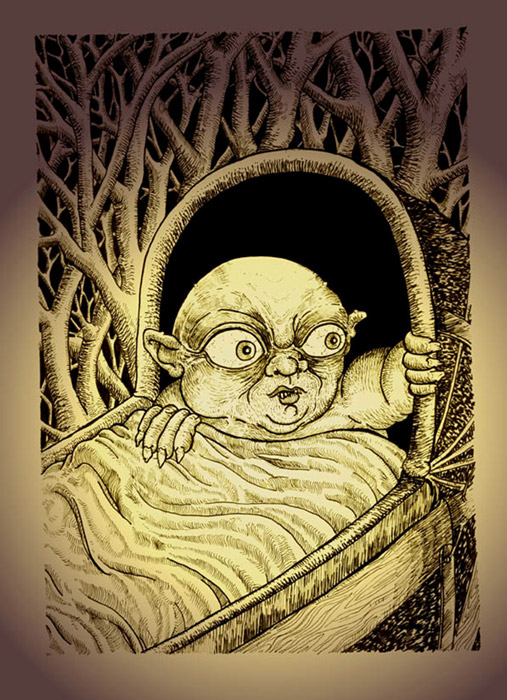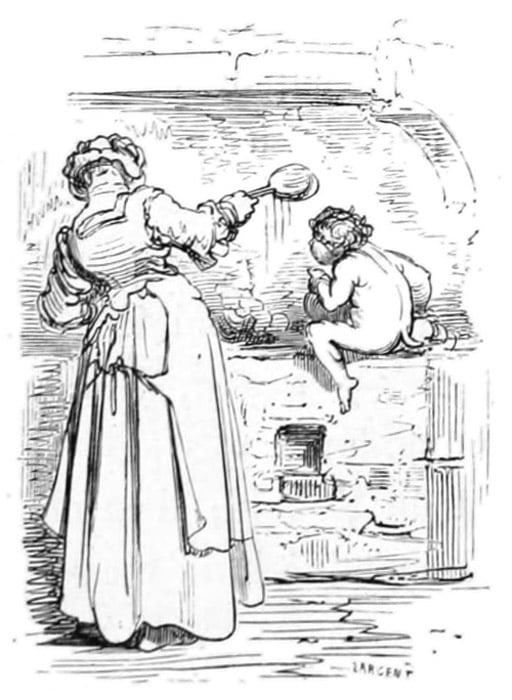
Swapping Babies: The Disturbing Faerie Changeling Phenomenon
The worldwide stories of faerie changelings come under a group of motifs recorded in the Aarne-Thompson folklore index as F321: ‘Faerie steals child from cradle and leaves faerie substitute.’ The basic premise of these motifs is that the faeries, through supernatural means, are capable of abducting babies from humans, whilst replacing them with one of their own, usually a wizened old faerie who would proceed to eat and drink voraciously, and maintain a surly silence. With external advice, the parents are usually advised of how to rid themselves of the changeling and restore their own baby from the faeries. The ruse is carried through and (usually) works.

19th-century image of a faerie changeling baby. (Courtesy author)
There are many variations on the story, but the Brothers Grimm summed up in concise form the main components of a typical changeling story from mid-19th-century Germany:
A mother had her child taken from the cradle by elves. In its place they laid a changeling with a thick head and staring eyes who would do nothing but eat and drink. In distress she went to a neighbor and asked for advice. The neighbor told her to carry the changeling into the kitchen, set it on the hearth, make a fire, and boil water in two eggshells. That should make the changeling laugh, and if he laughs it will be all over with him. The woman did everything just as her neighbor said. When she placed the eggshells filled with water over the fire, the changeling said:
‘Now I am as old
As the Wester Wood,
But have never seen anyone cooking in shells!’
And he began laughing about it. When he laughed, a band of little elves suddenly appeared. They brought the rightful child, set it on the hearth, and took the changeling away.

In folklore, supernatural creatures are often as susceptible to trickery as humans. (Public Domain)
A common variation on this plot would be for the changeling to be threatened with (or sometimes given) a roasting over the fire, which was usually enough for him to reveal himself and thereby break the spell. This basic story type can be found in folklore throughout the world, suggesting that the culturally embedded motifs represented by the stories had great importance to the people who propagated them.
Most of these folkloric changeling stories were first collected and published in the 19th century, but the changeling motif extends back into the Middle Ages. In the recent publication, Elf Queens and Holy Friars, Richard Green demonstrates that the changeling story was a cultural mainstay by at least the 12th century. In the early 13th century, William of Auvergne goes into some detail describing the ‘ignorant people’s’ belief in faerie changelings: “They say they are skinny and always wailing, and such milk-drinkers that four nurses do not supply a sufficient quantity of milk to feed one. These appeared to have remained with their nurses for many years, and afterwards to have flown away, or rather vanished.” He was not alone, amongst medieval chroniclers, to discuss the phenomenon with the implicit suggestion that the belief was a given reality amongst the rural population. But William, and the literate class of which he was a part, would usually use the changeling stories as demonstrations of the uneducated people’s foolish beliefs, and their need to swap their faerie-tales for the orthodox Christian position, which stated that such malevolent acts were the work of the Devil alone.

“They are skinny and always wailing” (Public Domain)
So, on the assumption that the changeling phenomenon was culturally important through the Middle Ages to the 19th century; where did it come from, why was it popularized, and why did the belief end so definitively, while other faerie beliefs continued? Maybe even more importantly; what does the phenomenon mean?
This FREE PREVIEW is just a taste of the great benefits you can find at Ancient Origins Premium.
Join us there ( with easy, instant access ) and reap the rewards: NO MORE ADS, NO POPUPS, GET FREE eBOOKS, JOIN WEBINARS, EXPEDITIONS, WIN GIFT GIVEAWAYS & more!

- Lessons from the Hidden World: Icelanders believed in elves, but it is probably not what you think
- The Origins of the Faeries: Encoded in our Cultures – Part I
- Mysterious Worlds: Travels to the Faerie and Shamanic Realms
Top Image: Sculpture of child, deriv. (CC BY 2.0)
By Neil Rushton
















Comments
Thanks for this AB. I agree, although on this occassion I stuck with a more conventional line of thought. As with most folklore, and especially faerie-lore, there is always a core of reality… even if that core is supernatural...
I’m right with all those questions at the end. These stories came from somewhere….I’m not sure we can ever truly know the source, but something happened, somewhere in time, that made this believeable to people for long periods of time. I struggle with feeling like we’ve lost all the magic the world has to give.
love, light and blessings
AB